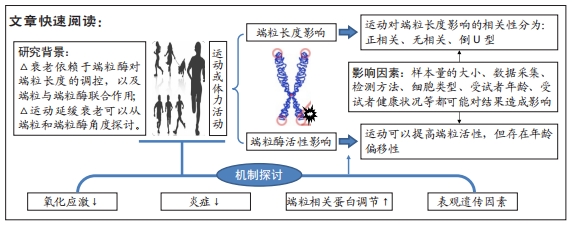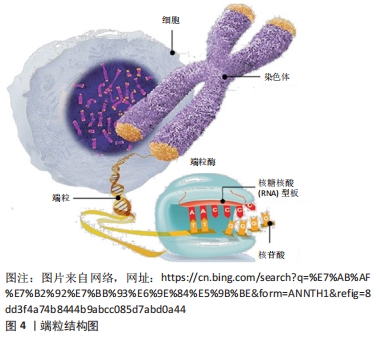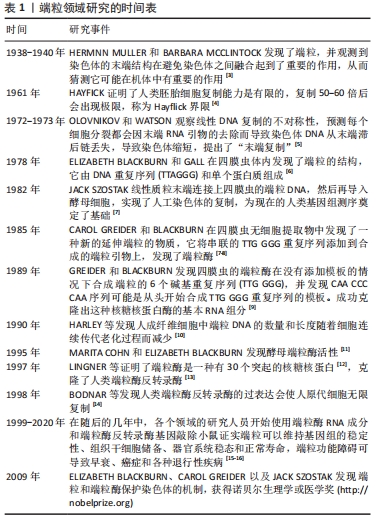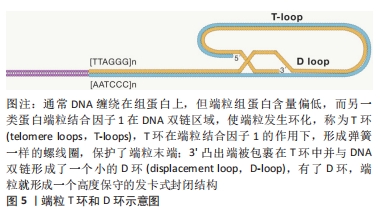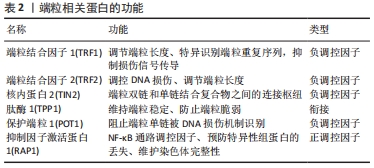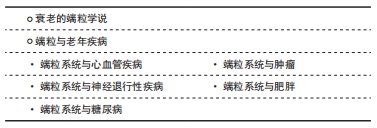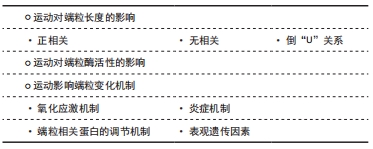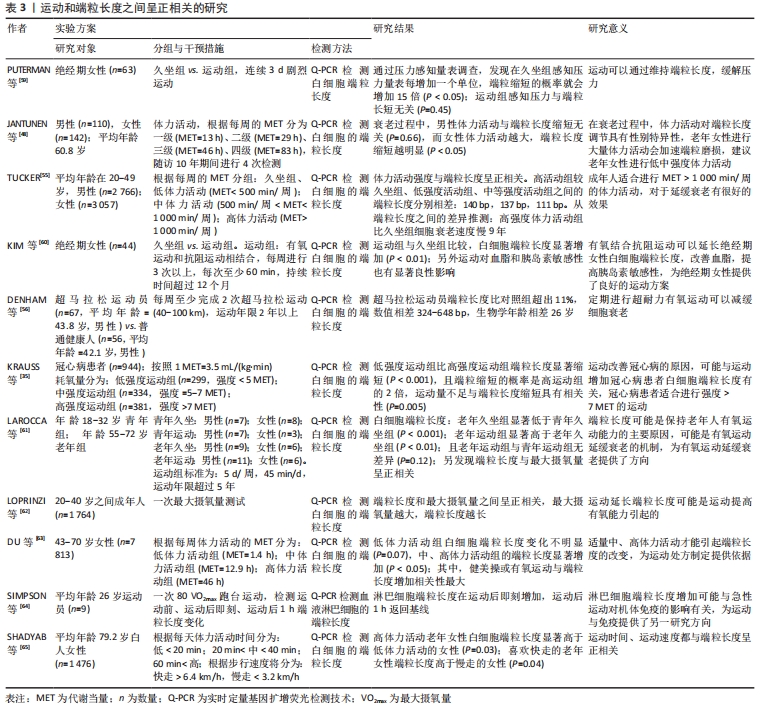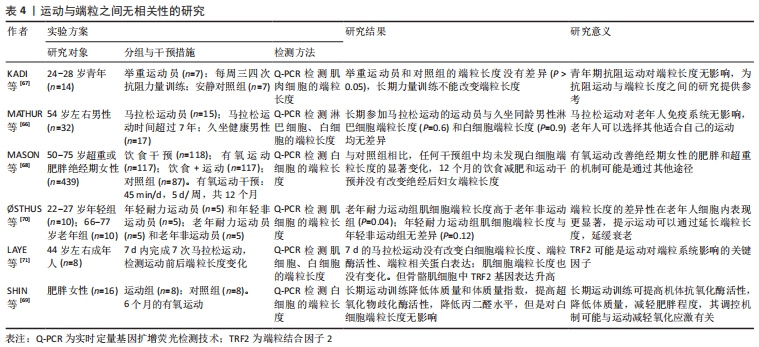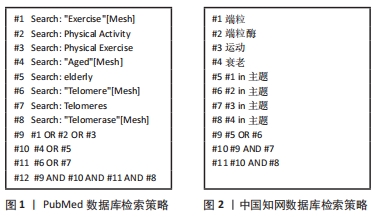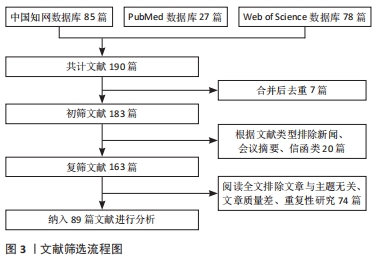[1] 高瑗,原新.中国老年人口健康转移与医疗支出[J].人口研究,2020, 44(2):60-72.
[2] 乔玉成,王卫军. 规律运动干预人类衰老过程的表观遗传学机制研究进展[J].北京体育大学学报,2016,39(1):61-67,75.
[3] MCCLINTOCK B. The Behavior in Successive Nuclear Divisions of a Chromosome Broken at Meiosis. Proc Natl Acad Sci U S A. 1939;25(8):405-416.
[4] WADE N. Hayflick’s Tragedy: The Rise and Fall of a Human Cell Line. Science. 1976;192(4235):125-127.
[5] WATSON JD. Origin of concatemeric T7 DNA. Nat New Biol. 1972;239(94): 197-201.
[6] BLACKBURN EH, GALL JG. A tandemly repeated sequence at the termini of the extrachromosomal ribosomal RNA genes in Tetrahymena. J Mol Biol. 1978;120(1):33-53.
[7] SZOSTAK JW, BLACKBURN EH. Cloning yeast telomeres on linear plasmid vectors. Cell. 1982;29(1):245-255.
[8] GREIDER CW, BLACKBURN EH. Identification of a specific telomere terminal transferase activity in Tetrahymena extracts. Cell. 1985;43(2 Pt 1):405-413.
[9] GREIDER CW, BLACKBURN EH. A telomeric sequence in the RNA of Tetrahymena telomerase required for telomere repeat synthesis. Nature. 1989;337(6205):331-337.
[10] LUNDBLAD V, BLACKBURN EH. RNA-dependent polymerase motifs in EST1: tentative identification of a protein component of an essential yeast telomerase. Cell. 1990;60(4):529-530.
[11] COHN M, BLACKBURN EH. Telomerase in yeast. Science. 1995;269(5222):396-400.
[12] LINGNER J, HUGHES TR, SHEVCHENKO A, et al. Reverse transcriptase motifs in the catalytic subunit of telomerase. Science. 1997;276(5312):561-567.
[13] COUNTER CM, MEYERSON M, EATON EN, et al. The catalytic subunit of yeast telomerase. Proc Natl Acad Sci U S A. 1997;94(17):9202-9207.
[14] WEINRICH SL, PRUZAN R, MA L, et al. Reconstitution of human telomerase with the template RNA component hTR and the catalytic protein subunit hTRT. Nat Genet. 1997;17(4):498-502.
[15] SADAIE M, NAITO T, ISHIKAWA F. Stable inheritance of telomere chromatin structure and function in the absence of telomeric repeats. Genes Dev. 2003;17(18):2271-2282.
[16] BIESSMANN H, MASON JM. Telomerase-independent mechanisms of telomere elongation. Cell Mol Life Sci. 2003;60(11):2325-2333.
[17] MOYZIS RK, BUCKINGHAM JM, CRAM LS, et al. A highly conserved repetitive DNA sequence, (TTAGGG)n, present at the telomeres of human chromosomes. Proc Natl Acad Sci U S A. 1988;85(18):6622-6626.
[18] 刘惠芬,李峰,彭东旭,等.端粒、端粒酶及靶向抗衰老研究[J].现代预防医学,2017,44(3):557-560.
[19] SMITH EM, PENDLEBURY DF, NANDAKUMAR J. Structural biology of telomeres and telomerase. Cell Mol Life Sci. 2020;77(1):61-79.
[20] MUSGROVE C, JANSSON LI, STONE MD. New perspectives on telomerase RNA structure and function. Wiley Interdiscip Rev RNA. 2018;9(2):10.
[21] JIANG J, WANG Y, SUŠAC L, et al. Structure of Telomerase with Telomeric DNA. Cell. 2018;173(5):1179-1190.e13.
[22] BREY EM, GREISLER HP. Telomerase expression in somatic cells. Lancet. 2005;365(9477):2068-2069.
[23] TORRES-MONTANER A. The telomere complex and the origin of the cancer stem cell. Biomark Res. 2021;9(1):81.
[24] MEYERSON M, COUNTER CM, EATON EN, et al. hEST2, the putative human telomerase catalytic subunit gene, is up-regulated in tumor cells and during immortalization. Cell. 1997;90(4):785-795.
[25] OZTURK S. Telomerase activity and telomere length in male germ cells. Biol Reprod. 2015;92(2):53.
[26] 吕欣桐.端粒、端粒酶与抗衰老的研究进展[J].医学信息(上旬刊),2011, 24(5):2857-2858.
[27] DER G, BATTY GD, BENZEVAL M, et al. Is telomere length a biomarker for aging: cross-sectional evidence from the west of Scotland? PLoS One. 2012; 7(9):e45166.
[28] BERNADOTTE A, MIKHELSON VM, SPIVAK IM. Markers of cellular senescence. Telomere shortening as a marker of cellular senescence. Aging (Albany NY). 2016;8(1):3-11.
[29] O’DONNELL CJ, DEMISSIE S, KIMURA M, et al. Leukocyte telomere length and carotid artery intimal medial thickness: the Framingham Heart Study. Arterioscler Thromb Vasc Biol. 2008;28(6):1165-1171.
[30] SAMANI NJ, BOULTBY R, BUTLER R, et al. Telomere shortening in atherosclerosis. Lancet. 2001;358(9280):472-473.
[31] NOWAK R, SIWICKI JK, CHECHLINSKA M, et al. Telomere shortening and atherosclerosis. Lancet. 2002;359(9310):976; author reply 976-977.
[32] FERNÁNDEZ-ALVIRA JM, FUSTER V, DORADO B, et al. Short Telomere Load, Telomere Length, and Subclinical Atherosclerosis: The PESA Study. J Am Coll Cardiol. 2016;67(21):2467-2476.
[33] OLIVIERI F, LORENZI M, ANTONICELLI R, et al. Leukocyte telomere shortening in elderly Type2DM patients with previous myocardial infarction. Atherosclerosis. 2009;206(2):588-593.
[34] TELLECHEA M, GIANOTTI TF, ALVARIÑAS J, et al. Telomere length in the two extremes of abnormal fetal growth and the programming effect of maternal arterial hypertension. Sci Rep. 2015;5:7869.
[35] KRAUSS J, FARZANEH-FAR R, PUTERMAN E, et al. Physical fitness and telomere length in patients with coronary heart disease: findings from the Heart and Soul Study. PLoS One. 2011;6(11):e26983.
[36] KIM SH SH, KAMINKER P, CAMPISI J. Telomeres, aging and cancer: in search of a happy ending. Oncogene. 2002;21(4):503-511.
[37] MENDER I, ZHANG A, REN Z, et al. Telomere Stress Potentiates STING-Dependent Anti-tumor Immunity. Cancer Cell. 2020;38(3):400-411.e6.
[38] YUAN X, DAI M, XU D. Telomere-related Markers for Cancer. Curr Top Med Chem. 2020;20(6):410-432.
[39] HUANG DS, WANG Z, HE XJ, et al. Recurrent TERT promoter mutations identified in a large-scale study of multiple tumour types are associated with increased TERT expression and telomerase activation. Eur J Cancer. 2015;51(8):969-976.
[40] NAULT JC, NINGARHARI M, REBOUISSOU S, et al. The role of telomeres and telomerase in cirrhosis and liver cancer. Nat Rev Gastroenterol Hepatol. 2019;16(9):544-558.
[41] JASKELIOFF M, MULLER FL, PAIK JH, et al. Telomerase reactivation reverses tissue degeneration in aged telomerase-deficient mice. Nature. 2011; 469(7328):102-106.
[42] TEDONE E, AROSIO B, COLOMBO F, et al. Leukocyte Telomere Length in Alzheimer’s Disease Patients with a Different Rate of Progression. J Alzheimers Dis. 2015;46(3):761-769.
[43] ZEE RY, CASTONGUAY AJ, BARTON NS, et al. Relative leukocyte telomere length and risk of incident ischemic stroke in men: a prospective, nested case-control approach. Rejuvenation Res. 2010;13(4):411-414.
[44] MARTIN-RUIZ C, DICKINSON HO, KEYS B, et al. Telomere length predicts poststroke mortality, dementia, and cognitive decline. Ann Neurol. 2006; 60(2):174-180.
[45] ROLYAN H, SCHEFFOLD A, HEINRICH A, et al. Telomere shortening reduces Alzheimer’s disease amyloid pathology in mice. Brain. 2011;134(Pt 7):2044-2056.
[46] GARCÍA-CALZÓN S, GEA A, RAZQUIN C, et al. Longitudinal association of telomere length and obesity indices in an intervention study with a Mediterranean diet: the PREDIMED-NAVARRA trial. Int J Obes (Lond). 2014; 38(2):177-182.
[47] IGLESIAS MOLLI AE, PANERO J, DOS SANTOS PC, et al. Metabolically healthy obese women have longer telomere length than obese women with metabolic syndrome. PLoS One. 2017;12(4):e0174945.
[48] JANTUNEN H, WASENIUS NS, GUZZARDI MA, et al. Physical Activity and Telomeres in Old Age: A Longitudinal 10-Year Follow-Up Study. Gerontology. 2020;66(4):315-322.
[49] GRUN LK, TEIXEIRA NDR JR, MENGDEN LV, et al. TRF1 as a major contributor for telomeres’ shortening in the context of obesity. Free Radic Biol Med. 2018;129:286-295.
[50] SHIN YA. How Does Obesity and Physical Activity Affect Aging?: Focused on Telomere as a Biomarker of Aging. J Obes Metab Syndr. 2019;28(2):92-104.
[51] WANG J, DONG X, CAO L, et al. Association between telomere length and diabetes mellitus: A meta-analysis. J Int Med Res. 2016;44(6):1156-1173.
[52] TAMURA Y, TAKUBO K, AIDA J, et al. Telomere attrition and diabetes mellitus. Geriatr Gerontol Int. 2016;16 Suppl 1:66-74.
[53] WILLEIT P, RASCHENBERGER J, HEYDON EE, et al. Leucocyte telomere length and risk of type 2 diabetes mellitus: new prospective cohort study and literature-based meta-analysis. PLoS One. 2014;9(11):e112483.
[54] SETHI I, BHAT GR, SINGH V, et al. Role of telomeres and associated maintenance genes in Type 2 Diabetes Mellitus: A review. Diabetes Res Clin Pract. 2016;122:92-100.
[55] TUCKER LA. Physical activity and telomere length in U.S. men and women: An NHANES investigation. Prev Med. 2017;100:145-151.
[56] DENHAM J, NELSON CP, O’BRIEN BJ, et al. Longer leukocyte telomeres are associated with ultra-endurance exercise independent of cardiovascular risk factors. PLoS One. 2013;8(7):e69377.
[57] BENDIX L, GADE MM, STAUN PW, et al. Leukocyte telomere length and physical ability among Danish twins age 70+. Mech Ageing Dev. 2011;132 (11-12):568-572.
[58] LUDLOW AT, ZIMMERMAN JB, WITKOWSKI S, et al. Relationship between physical activity level, telomere length, and telomerase activity. Med Sci Sports Exerc. 2008;40(10):1764-1771.
[59] PUTERMAN E, LIN J, BLACKBURN E, et al. The power of exercise: buffering the effect of chronic stress on telomere length. PLoS One. 2010;5(5):e10837.
[60] KIM JH, KO JH, LEE DC, et al. Habitual physical exercise has beneficial effects on telomere length in postmenopausal women. Menopause. 2012; 19(10):1109-1115.
[61] LAROCCA TJ, SEALS DR, PIERCE GL. Leukocyte telomere length is preserved with aging in endurance exercise-trained adults and related to maximal aerobic capacity. Mech Ageing Dev. 2010;131(2):165-167.
[62] LOPRINZI PD. Cardiorespiratory Capacity and Leukocyte Telomere Length Among Adults in the United States. Am J Epidemiol. 2015;182(3):198-201.
[63] DU M, PRESCOTT J, KRAFT P, et al. Physical activity, sedentary behavior, and leukocyte telomere length in women. Am J Epidemiol. 2012;175(5): 414-422.
[64] SIMPSON RJ, COSGROVE C, CHEE MM, et al. Senescent phenotypes and telomere lengths of peripheral blood T-cells mobilized by acute exercise in humans. Exerc Immunol Rev. 2010;16:40-55.
[65] SHADYAB AH, LAMONTE MJ, KOOPERBERG C, et al. Leisure-time physical activity and leukocyte telomere length among older women. Exp Gerontol. 2017;95:141-147.
[66] MATHUR S, ARDESTANI A, PARKER B, et al. Telomere length and cardiorespiratory fitness in marathon runners. J Investig Med. 2013;61(3): 613-615.
[67] KADI F, PONSOT E, PIEHL-AULIN K, et al. The effects of regular strength training on telomere length in human skeletal muscle. Med Sci Sports Exerc. 2008;40(1):82-87.
[68] MASON C, RISQUES RA, XIAO L, et al. Independent and combined effects of dietary weight loss and exercise on leukocyte telomere length in postmenopausal women. Obesity (Silver Spring). 2013;21(12):E549-554.
[69] SHIN YA, LEE JH, SONG W, et al. Exercise training improves the antioxidant enzyme activity with no changes of telomere length. Mech Ageing Dev. 2008;129(5):254-260.
[70] ØSTHUS IB, SGURA A, BERARDINELLI F, et al. Telomere length and long-term endurance exercise: does exercise training affect biological age? A pilot study. PLoS One. 2012;7(12):e52769.
[71] LAYE MJ, SOLOMON TP, KARSTOFT K, et al. Increased shelterin mRNA expression in peripheral blood mononuclear cells and skeletal muscle following an ultra-long-distance running event. J Appl Physiol (1985). 2012; 112(5):773-781.
[72] SAVELA S, SAIJONMAA O, STRANDBERG TE, et al. Physical activity in midlife and telomere length measured in old age. Exp Gerontol. 2013;48(1):81-84.
[73] RAE DE, VIGNAUD A, BUTLER-BROWNE GS, et al. Skeletal muscle telomere length in healthy, experienced, endurance runners. Eur J Appl Physiol. 2010; 109(2):323-330.
[74] WERNER C, FÜRSTER T, WIDMANN T, et al. Physical exercise prevents cellular senescence in circulating leukocytes and in the vessel wall. Circulation. 2009;120(24):2438-2447.
[75] ZIETZER A, BUSCHMANN EE, JANKE D, et al. Acute physical exercise and long-term individual shear rate therapy increase telomerase activity in human peripheral blood mononuclear cells. Acta Physiol (Oxf). 2017;220(2): 251-262.
[76] CLUCKEY TG, NIETO NC, RODONI BM, et al. Preliminary evidence that age and sex affect exercise-induced hTERT expression. Exp Gerontol. 2017;96:7-11.
[77] PUTERMAN E, WEISS J, LIN J, et al. Aerobic exercise lengthens telomeres and reduces stress in family caregivers: A randomized controlled trial - Curt Richter Award Paper 2018. Psychoneuroendocrinology. 2018;98:245-252.
[78] OIKAWA S, KAWANISHI S. Site-specific DNA damage at GGG sequence by oxidative stress may accelerate telomere shortening. FEBS Lett. 1999;453(3): 365-368.
[79] MISHRA S, KUMAR R, MALHOTRA N, et al. Mild oxidative stress is beneficial for sperm telomere length maintenance. World J Methodol. 2016;6(2):163-170.
[80] BOONEKAMP JJ, BAUCH C, MULDER E, et al. Does oxidative stress shorten telomeres? Biol Lett. 2017;13(5):20170164.
[81] ZHANG J, RANE G, DAI X, et al. Ageing and the telomere connection: An intimate relationship with inflammation. Ageing Res Rev. 2016;25:55-69.
[82] SOLTANI N, MARANDI SM, KAZEMI M, et al. The Exercise Training Modulatory Effects on the Obesity-Induced Immunometabolic Dysfunctions. Diabetes Metab Syndr Obes. 2020;13:785-810.
[83] LYU L, HE S, ZHANG H, et al. TNFα Mediates the Interaction of Telomeres and Mitochondria Induced by Hyperglycemia: A Rural Community-Based Cross-Sectional Study. Oxid Med Cell Longev. 2020;2020:8235873.
[84] WANG F, PODELL ER, ZAUG AJ, et al. The POT1-TPP1 telomere complex is a telomerase processivity factor. Nature. 2007;445(7127):506-510.
[85] WERNER C, HANHOUN M, WIDMANN T, et al. Effects of physical exercise on myocardial telomere-regulating proteins, survival pathways, and apoptosis. J Am Coll Cardiol. 2008;52(6):470-482.
[86] SHARMA NK, REYES A, GREEN P, et al. Human telomerase acts as a hTR-independent reverse transcriptase in mitochondria. Nucleic Acids Res. 2012; 40(2):712-725.
[87] ZHANG D, SUN X, LIU J, et al. Homocysteine accelerates senescence of endothelial cells via DNA hypomethylation of human telomerase reverse transcriptase. Arterioscler Thromb Vasc Biol. 2015;35(1):71-78.
[88] 刘波,陈祥和,杨康,等.骨代谢紊乱的表观遗传重编程与运动调控[J].中国组织工程研究,2021,25(20):3210-3218.
[89] DEMINICE R, RIBEIRO DF, FRAJACOMO FT. The Effects of Acute Exercise and Exercise Training on Plasma Homocysteine: A Meta-Analysis. PLoS One. 2016;11(3):e0151653.
|
